
Vol. 6, No.12, December 2010 |
 Printer-Friendly PDF Version Printer-Friendly PDF Version |
"Building a Better Team"
Register for 2011 Florida SART Planning Meeting
Register now for the 2011 SART Planning Meeting February 28– March 2, 2011. It will be held at the Altamonte Springs–Orlando North Hilton, a Florida green hotel and conference center.
- Room rates just $93/per night.
- No event fee for registered participants, but go to www.flsart.org to register and book your room (www.flsart.org/hotel). This needs to be done right away and in no case later than January 28 to be eligible for SART’s group rate.
- There’s a light fare reception the evening of February 28 and due to the generosity of several sponsors, complimentary breakfasts will be served on March 1 and 2. On March 1 during the SART awards ceremony, lunch is also complimentary.
Agenda
| Monday | |
| 1:00 - 5:00 pm | Welcome: Dr. Tom Holt, State Veterinarian
 Dr. Tom Holt, Florida State Veterinarian is scheduled to deliver the welcome address to the 2011 State Planning Meeting. (Photo from 2007 Conference, l-r: Dr. Holt, David Perry, Dr. Paul Gibbs.) Dr. Tom Holt, Florida State Veterinarian is scheduled to deliver the welcome address to the 2011 State Planning Meeting. (Photo from 2007 Conference, l-r: Dr. Holt, David Perry, Dr. Paul Gibbs.)
USDA APHIS/Animal Care |
| 6:30 - 7:30 pm |
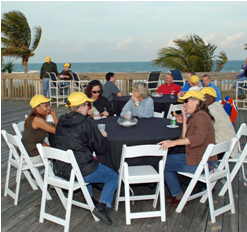 SART Mixer
SART Mixer (Photo: SART Mixer from 2009 Conference) |
| Tuesday | |
| 8:00 am - Noon | Problem solving working groups |
| Noon | Awards Luncheon |
| Afternoon | Field training |
| Wednesday | |
| 8:00 am - Noon | MOU between FVMA & FDACS |
Questions? Check with Michael Turner (850) 410-6761 (turnerm@doacs.state.fl.us) or Joe Kight (kightj@doacs.state.fl.us). A Florida green hotel and conference center, the Hilton Orlando/Altamonte Springs has a web site at http://www1.hilton.com/en_US/hi/hotel/ALTAHHF-Hilton-Orlando-Altamonte-Springs-Florida/index.do.
[top]
2011 Agroterrorism Preparedness Classes
Florida’s Department of Agriculture and Consumer Services (FDACS) Office of Agricultural Emergency Preparedness partners with the Western Institute of Food Safety and Security (WIFSS) to present DHS Certified Agroterrorism Courses.
All courses are free. On-site registration begins at 8:00 am and, unless otherwise specifically advertised, workshops end at 4:00 pm. Additional sponsoring partners include the Institute for Food and Agricultural Sciences (IFAS-Extension), the Florida Department of Health and the Regional Domestic Security Task Forces. The following courses are still open:
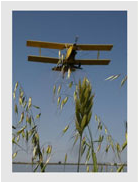
AWR-154 Principles of National Incident Management System,
Team Building, and Risk Communication
Tuesday, February 5, 2011
Escambia County Public Safety, 6575 North "W" St., Pensacola
AWR-155 Principles of Frontline Response to Agroterrorism
and Food Systems’ Disasters
Wednesday, January 19, 2011
Hillsborough County Extension Office, 5339 S CR 579, Seffner
Thursday, January 20, 2011
Orange County Sheriff's Office Central Operations Center, Mel Martinez Auditorium, 2500 W Colonial Dr., Orlando
Wednesday, February 16, 2011
Florida Department of Agriculture and Consumer Services, Conner Administration Building (Eyster Auditorium), 3125 Conner Blvd., Tallahassee
Tuesday, March 15, 2011
Jacksonville Regional Operations Center, 921 N Davis St. Building E, Jacksonville
Wednesday, March 16, 2011
USDA Farm Service Agency, 4401 NW 25th Place, Suite M Gainesville
AWR-156 Principles of Planning and Implementing Recovery
Tuesday, March 22, 2011
Division of Emergency Management, Palm Beach County, 20 S Military Trail, West Palm Beach
Wednesday, March 23, 2011
Alvin Sherman Library, Research, and Information Technology Center, 3100 Ray Ferrero Jr. Blvd., Fort Lauderdale
To register for a course or for more information go to the WIFSS website at:
Registration:
http://wifss.ucdavis.edu/agroterrorism/classes/classesbydate.php
Course Information:
http://wifss.ucdavis.edu/agroterrorism/classes/course_desc.php
Contact John Terry (850-410-6756 or terryj1@doacs.state.fl.us ) with questions.
[top]
FACA News
SART Partner Elects Officers, Directors

“With 125 to 130 people attending we had a great meeting,” says Lois Kostroski, Florida Animal Control Association (FACA) Executive Director about the November FACA conference in Orlando. “Declining budgets and increased demand for services were on everyone’s mind, but I can’t say we came up with stunning answers for those difficulties except to increase our local volunteer outreach and continue to work hard to serve our communities in the most professional manner possible.”
New officers are:
President – Scott Trebatoski, Jacksonville Animal Care and Protective Services
Vice President – David Walesky, Palm Beach County Animal Care and Control
Treasurer –Dr. Dewayne Taylor, Pinellas County Animal Services.
The FACA Board is composed of Jill Lancon (Marion County Animal Center), Paul Studivant (St. Johns County Animal Control), Richard Ziegler (Leon County Animal Control) and new board members Dennis McCullough (Hillsborough County Animal Services), Katherine Lockett (Orange County Animal Services) and Steven Horstman (Polk County Animal Services).
FACA 2010 Awards
- Employee of the Year
- Christina Seghi, Hillsborough County Animal Services
“Christina began in 2000 as a Vet Assistant, quickly was promoted to Vet Tech, and gained recognition as an outstanding employee. She was chosen to attend a weeklong training session with BadRap in California (http://www.badrap.org/rescue/index.html), and came back to coordinate the county’s first Pit Bull Ambassador Program and to date that program has placed several hundred pit bulls in lifelong homes. Her success led to a personal request from BadRap to assist them in evaluating pit bulls seized in a dog fighting raid in northern Florida. Her agency described her as ‘exemplifying the best that animal care and control has to offer’ and someone to build the future of the department around.” - Honorable Mention: Jennifer Arn, Santa Rosa County; Hilary Hynes, Alachua County; and Gwen Jones, Alachua County.
- Animal Control fficer of the Year
- John Douglass, Pasco County Animal Services
“John has been with his agency since 2005 and he sets the example for others. He demonstrated those traits last year during an outbreak of distemper, volunteering to assist with the decontamination of the shelter, pressure cleaning on two separate occasions. When the county held clinics for vaccination against distemper, he provided security, ensuring animals and citizens were safe. All that was in addition to the 200 square miles he covers as an ACO.” - Honorable Mention: David Freeman, Jacksonville; Kimberly Gallagher, Santa Rosa County; Jessica Lauginger, Alachua County; and Megan Smulski, Orange County.
- Outstanding Cooperative Team Achievement
- Miami-Dade Animal Services
“Miami-Dade accomplished spay/neutering of more than 4,000 cats without an impact on the operational budget, thanks to staff, volunteers and sponsors. Initiatives included such events as a Spay-A-Thon for feral and free-roaming cats using mobile units where 216 cats were spayed/neutered and rabies vaccinated. The coordination and collaboration of these events plus an ongoing weekly spay/neuter program exemplifies the FACA definition for this award.” - Honorable Mention: Alachua County with UF Shelter Medicine Club and Santa Rosa County with MediaCom.
- Outstanding Agency of the Year
- Polk County Sheriff’s Office Animal Control
This agency covers 2,000 square miles with half-a-million residents. They partner with animal welfare groups, the county health department, humane society, Ridge Veterinary Medical Society and approximately 90 not-for-profit agencies. Their inmate work program saved about $250,000 in 2010. FACA notes, “We were especially impressed with their internal ACO Training and Evaluation Program for new hires. Their eight-week program enhances the required certification with two weeks of classroom and strict supervision and evaluation in the field. This agency is a prime example of the depth and breadth of commitment to exceptional animal care and control.” - Honorable Mention: Jacksonville Animal Care & Protective Services and Santa Rosa County Animal Services
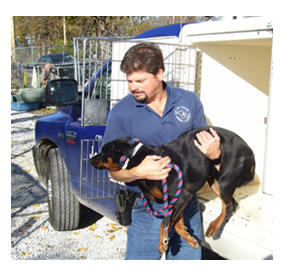
North Florida's Disappearing Water
A SART Special Report
By Rick Sapp, Editor

Will office water coolers go the way of the Walkman? Will your boss charge half-a-dollar to use the toilet; another quarter to your wash hands?
Unless we act, the steady decline of the Floridan Aquifer, the pure groundwater in Florida’s limestone bedrock, may steal our children’s birthright.
Is this an all-hazard issue that can affect the animal and agricultural sectors of Florida? You bet it is.
A Looming Emergency?
Our water supply is wasting away.
Fanning Springs has nitrogen levels 100 times greater than prior to development with thick green algae and low oxygen levels. Ten years ago it was a 1st Magnitude Spring (flow exceeding 100 cu-ft/second); now, 2nd Magnitude.
White Sulphur Springs, at the bathhouse in White Springs? Dry.
Big Shoals on the Suwannee? Your office could picnic on the ledge.
Silver Springs in Ocala? A skeleton of the crystal clear water where Tarzan swam with Jane.
 Tarzan (Johnny Weismuller in this old photo) would not recognize the springs where he once cavorted with Jane and Boy.
Tarzan (Johnny Weismuller in this old photo) would not recognize the springs where he once cavorted with Jane and Boy. According to the Suwannee River Water Management District (SRWMD), “The water resources of the northeastern portion of the District are in decline.”
Even worse says SRWMD hydrogeologist Carlos Herd, “It’s hard to say how much water is available.”
It’s like trying to measure a baseball as it arcs from the bat to the bleachers.
The Floridan Aquifer underlies all of Florida and the southern zones of Alabama, Georgia, Mississippi and South Carolina, about 100,000 square miles. Clean, fresh water flows from zones of high pressure in central Alabama, for instance, toward the coast.
We imagine it will always be there for us, but maybe not.
University of Florida law professor Richard Hamann, a board member with the St. Johns River WMD says “[North Florida is] seeing what others have struggled with before.
“Tampa Bay recognized too late that it was using too much water and it has been a long, difficult, contentious, litigious and expensive process for them.
“Orlando has so impacted its wetlands and water sources that it’s going to require aggressive conservation and alternative water supplies.”
SRWMD vice chair David Flagg says, “Traditionally [North Florida] had an abundance of water, but it’s a diminishing abundance…and it’s hard to get people excited about it.”
What’s the Problem?
Web Sites Worth Watching
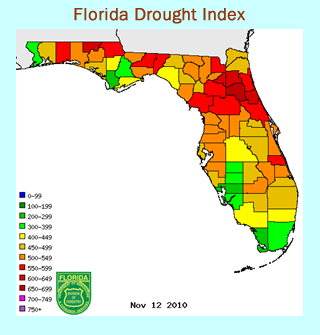
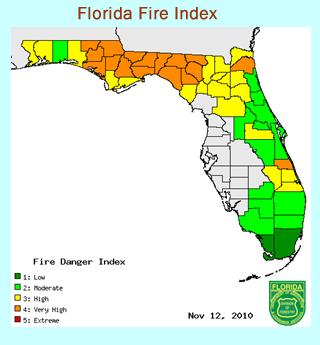
Drought: According to Teresa Monson of the St. Johns River WMD, “Florida is currently experiencing drought because of lack of rainfall. It’s odd because we’re a peninsula surrounded by water and have thousands of lakes, springs and rivers. The driest years Florida experienced since record-keeping began in 1932 were 2006 and 2007.”( Drought Index - http://flame.fldof.com/index.html)
Population increase: From 1990 to 2000 Florida’s growth rate was an astonishing 23.5 percent, increasing population from 13 to 16 million; today it’s 18.5 million. The average person uses 100+ gallons of water per day. Multiply that by 18.5 million. Teresa Monson says, “By 2025, we’ll need two billion more gallons of water a day.”
Even this seemingly obvious answer is arguable, though. Cynthia Barnett, who reported on the water crisis in her 2008 book Mirage says, “Contrary to popular belief, population growth has not caused an explosion in our water consumption.” Her answer is simple: careless use.
“South Florida's residents…use…an average 179 gallons per person per day. In comparison, drought-stricken Atlanta uses 120 gallons per capita daily use,” Barnett says. “Sarasota County lowered per-capita water use from 140 gallons to 90 gallons a day. Statewide, Floridians use an average 157.5 gallons a day.”
Bottled water: America spends $15 billion per year on bottled water. It is “an issue.”
The Suwannee River WMD permits three active water bottling operations and authorizes them to pump 2.892 million gallons per day (mgd).
Bottled water operations in the St. Johns WMD are allocated a combined 1.69 million gallons of water per day.
“To give these numbers context,” Monson says, “the total amount of groundwater (the primary source of water for drinking, industry, agriculture and recreation) used in this district in 2006 was 1.6 billion gallons per day. The amount allocated for bottling plants represents approximately 1/10 of one percent of the groundwater used.”
Springs authority Jim Stevenson says giving away water is like giving blood: “How many pints can you donate before you die?”
“It’s a scary situation,” says Dr. Bob Knight, founder and president of Wetland Solutions, Gainesville. “There’s just not enough return to the aquifer.”
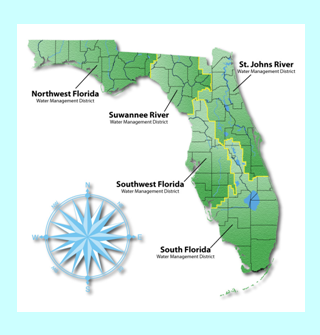
Cops or Conservation?
In 1972, Florida’s Water Resources Act divided the state into five Water Management Districts www.dep.state.fl.us
/secretary/watman/. Their task is to “manage water and related natural resources by providing water quality and quantity monitoring, research, regulation, land acquisition and management and flood protection.”
Actually delivering water to you is the function of local utilities, of which there are dozens in the state, most of whom have service areas that cross governmental jurisdictions.
Conservation is on the mind of local officials and it should rise to the consciousness of the responder community. After all, if there is not enough water to douse wildfires or irrigate citrus and if our governments use scarce resources to build more desalination plants, our way of life will change.
Alachua County’s Chris Bird says, “We urge people to conserve. We don’t ticket [for improper watering or careless wastage], but it could come to that. We’re going into an extended drought over the next six months. You can make the most difference by convincing people to cut lawn watering which is up to half of all residential usage and the biggest single identifiable residential water use.”
“The biggest agricultural crop in the U.S. is lawns,” says David Flagg. “Why do we pour drinking water on grass? We need water a lot more than we need grass!”
Former Florida Farm Bureau president Arlen Jumper is in the Agricultural Hall of Fame. Today, he manages the Jones Turf Grass Farm in Marion County and is a board member of the St. Johns River WMD.
“The WMD is in the early stages of rule-making for water conservation,” Jumper says. “Soon cities and new developments will need [written] conservation plans.”
What’s Your Personal Water Usage?
So are you part of the problem or part of the answer?
The U.S. Geological Survey at http://ga.water.usgs.gov/edu/sq3.html offers an on line Questionnaire to calculate estimated personal water use. It includes all normal activities for a Saturday at home, but omits such important things as lawn watering, car washing and pool maintenance.

For example, the author estimated: bath 0, shower 1 (10 minutes), teeth brushings 3, hand/face washings 3, face/leg shaving 0, dishwasher load 0, dish washing by hand 2, clothes wash 2, toilet flush 5 and water drunk 5 at 8 ounces each. The USGS calculator responded with an estimate of 76.3 gallons.
USGS says these are the numbers used in the calculations:
Bath: 50 gallons
Shower: 2.5 gallons per minute
Teeth brushing: 1 gallon
Hands/face washing: 1 gallon
Face/leg shaving: 1 gallon
Dishwasher: 20 gallons/load
Dishwashing by hand: 5 gallons/load
Clothes washing (machine): 10 gallons/load
Toilet flush: 3 gallons
Glasses of water drunk: 8 oz. per glass (1/16th of a gallon)
[top]
Animal CSI
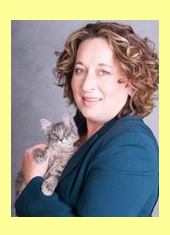 Dr. Melinda Merck, UF-CVM
Dr. Melinda Merck, UF-CVMIt’s almost too good to be true. Animal CSI. And a Florida-based veterinarian is leading the way, has in fact written the book on this subject. Dr. Melinda Merck is associated with the Maddie’s Shelter Program at UF’s College of Veterinary Medicine and with the ASPCA. To learn more about “Animal CSI,” the Maddie’s Shelter Program and Dr. Merck’s work on behalf of animals, try these sites: http://www.veterinaryforensics.com/ and http://www.ufsheltermedicine.com.
 Animal CSI - How do you handle snakes in an emergency, especially exotic invasive snakes? Does a python have "rights" a responder must respect?
Animal CSI - How do you handle snakes in an emergency, especially exotic invasive snakes? Does a python have "rights" a responder must respect?A November 25th article in the Tampa Tribune highlighted Dr. Merck’s work – animal cruelty to puppy mills, dog fighting and animal hoarding – including co-founding a first-of-its-kind veterinary forensic science training program at the University of Florida in Gainesville. “Demand for forensic veterinarians has grown,” she says, “as states have toughened animal cruelty laws. And law enforcement nationwide has increasingly recognized that those who abuse animals are likely to eventually commit crimes against people.” To read the article, go to: http://www2.tbo.com/content/2010/nov/25/animal-csi-vets-learn-how-to-investigate-crimes/.
[top]
FL-SARC Web Site Up-and-Running
“We have our website up,” says Connie Brooks of the Florida State Animal Response Coalition (FL-SARC). “While it is still a work in progress, people can check in and follow the group’s development at www.flsarc.org.”
“Three Awareness Level Animal Sheltering training courses are coming up,” Pam Burns says. [Until the web site is fully operational and registration materials are posted, interested attendees may contact Pam at pamburnssarc@gmail.com.]
January 29:
Cat Depot www.catdepot.org 2542 17th St., Sarasota
February 5:
Pinellas County Animal Services at the Botanical Gardens, 12520 Ulmerton Rd., Largo
TBD: Tallahassee
“The Florida State Animal Response Coalition (FL-SARC) is a not-for-profit organization dedicated to all-hazard disaster preparation, planning, training, response and recovery during animal emergencies. FL-SARC trains participants to facilitate a safe and efficient response to animal emergencies on the local, state and national level. FL-SARC is organized under the auspices of Florida state and local Emergency Management agencies utilizing the principles of the Incident Command System (ICS).
“FL-SARC is a coalition of individuals, groups and businesses local and/or national in scope with the desire to plan, train, practice and respond to animal emergencies in the state of Florida.”
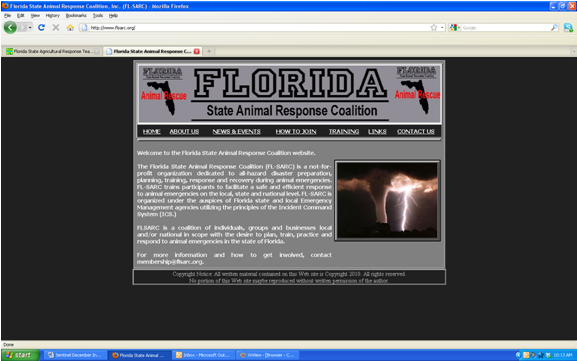
FL-SARC officers and directors are: Connie Brooks, President; Laura Bevan, Treasurer; Meredith Shields, Secretary; Ronnie Graves, Board Member; and Consie von Gontard, Board Member and Director of Training.
For more information email info@flsarc.org and to get involved membership@flsarc.org . Florida State Animal Response Coalition, 11927 SW 31st Terrace, Webster, FL 33597-7705.
[top]
Who is an animal hoarder?
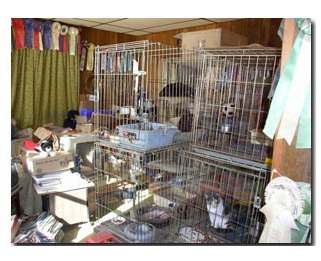
In a 1999 study Dr.Gary Patronek, DVM, a professor at Philadelphia’s Tufts University defines animal hoarders as people who:
- accumulate a large number of animals;
- fail to provide minimal standards of nutrition, sanitation and veterinary care; and
- fail to act on the deteriorating condition of the animals, the environment and their own health.
Hoarders justify their behavior with the view that the animals are surrogate children and that no one else can care for them. They fear that if they seek help the animals will be euthanized.
More recently, in the publication Animal Hoarding from the Hoarding of Animals Research Consortium, Patronek and co-writers list four key characteristics:
- failure to provide minimal standards of sanitation, space, nutrition and veterinary care;
- inability to recognize the effects of this failure on the welfare of the animals, human members of the household, and the environment;
- obsessive attempts to accumulate or maintain a collection of animals in the face of progressively deteriorating conditions; and
- denial or minimization of problems and living conditions for people and animals.
[top]
News, Notes, Items of Interest
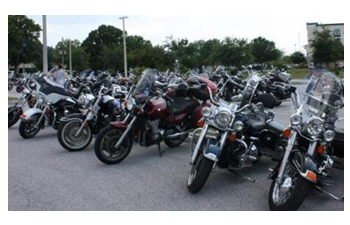
Bay Area DART
Bay Area DART recently teamed with Fletcher’s Harley Davidson to host the First Ever DART Fun Run for motorcyclists. The event helped raise more than $4,000 for the DART team’s work on behalf of animals.
“Thank you to these wonderful organizations for providing stops to our bikers along the way,” notes the Bay Area DART web site at www.bayareadart.org. “These organizations opened their doors and allowed our bikers a chance to tour their facility and give people the opportunity to see what great work they do for our Tampa Bay community! [Equestrian Club Country, Humane Society of Tampa Bay, Big Cat Rescue, Suncoast Seabird Sanctuary and SPCA Tampa Bay]”

Of Water, Strawberries and Freezing Weather
The Southwest Florida Water Management District may soon vote to implement frost freeze water restrictions around Dover and Plant City, an act which would hamper the ability of strawberry farmers to respond to freezing weather.
"Our goal is a 20 percent reduction in frost freeze water use over the next 10 years," explained SWFWMD spokesperson Robyn Felix. Several ideas – recovery ponds, clothes and foams – are under discussion to reduce water usage.
Farmers used so much water to save crops during last year’s unprecedented 11-day freeze, their response caused millions of dollars worth of damage: 750 wells dried out and nearly 150 sinkholes opened. The freeze killed many crops and left farmers with hundreds of thousands of dollars in losses. The threat of a water reduction could mean more of the same.
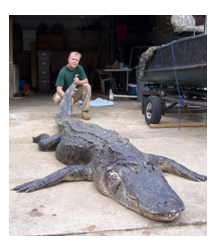
Alligator Sets Record
Be careful where you put your feet and remember that for a short time an alligator can run faster than a racehorse!
So the record we’re talking about is not the Gator-Seminole football or basketball games, but a real live alligator, Alligator mississippiensis, trapped on November 1st that weighed 654 pounds and measured 14 feet, 3 ½ inches.
The Fish & Wildlife Conservation Commission, a SART Partner, says this gator, taken from Lake Washington near Melbourne, is the longest alligator recorded, but the heaviest was taken in 1989: 1,043 pounds.
[top]
About the SART Sentinel |
The SART SENTINEL is an E-mail newsletter prepared monthly by the members of the Florida State Agricultural Response Team. Past issues of the Sentinel are archived on the Florida SART Web Site, www.flsart.org. If you have a story or photo that you would like to have considered for publication in The SART SENTINEL, please contact the Editors. Editor: Rick Sapp, PhD, Technical Writer, Florida Department of Agriculture & Consumer Services, Division of Animal Industry [rsa5@cox.net] Associate Editor: Joe Kight, State ESF-17 Coordinator, Florida Department of Agriculture & Consumer Services, Division of Animal Industry [kightj@doacs.state.fl.us] [top] |
